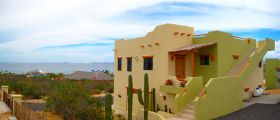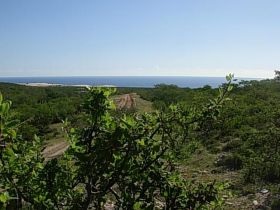How much rain does Los Cabos - La Paz, Mexico get? When is the Rainy Season and the Dry Season in Los Cabos - La Paz, Mexico and what is it like?
Alfonso Reynoso - Jabre Construcción
 The stronger rains come around September in Baja California Sur. It rains through July, August and September but 50% of the stronger rains are in September because the hurricanes usually come during this month. It rains sporadically throughout the year but they are not as strong as hurricanes, which could sometimes be dangerous. The locals of La Paz, La Ventana (a small village 40 miles south of La Paz) and in Cabo love to go out when it rains. They love getting wet in the rain. The...
The stronger rains come around September in Baja California Sur. It rains through July, August and September but 50% of the stronger rains are in September because the hurricanes usually come during this month. It rains sporadically throughout the year but they are not as strong as hurricanes, which could sometimes be dangerous. The locals of La Paz, La Ventana (a small village 40 miles south of La Paz) and in Cabo love to go out when it rains. They love getting wet in the rain. The... The stronger rains come around September in Baja California Sur. It rains through July, August and September but 50% of the stronger rains are in September because the hurricanes usually come during this month. It rains sporadically throughout the year but they are not as strong as hurricanes, which could sometimes be dangerous. The locals of La Paz, La Ventana (a small village 40 miles south of La Paz) and in Cabo love to go out when it rains. They love getting wet in the rain. The kids go out to play with their floats and they play in the mud. As long as there is no hurricane, it is like a holiday when it rains here!
The stronger rains come around September in Baja California Sur. It rains through July, August and September but 50% of the stronger rains are in September because the hurricanes usually come during this month. It rains sporadically throughout the year but they are not as strong as hurricanes, which could sometimes be dangerous. The locals of La Paz, La Ventana (a small village 40 miles south of La Paz) and in Cabo love to go out when it rains. They love getting wet in the rain. The kids go out to play with their floats and they play in the mud. As long as there is no hurricane, it is like a holiday when it rains here! How you would like the weather in Los Cabos and La Paz depends on where you are from and what kind of weather you are used to. There are people who come here and find the weather pleasant. I have friends from Alaska and Canada that come here in January, and when I tell them that it’s cold during January, they laugh at me.
(House with rooftop patio designed by Jabre Construccion, La Ventana, Baja California Sur, Mexico, pictured.)
Posted July 8, 2016
Paul Clark - East Cape Homes
 The rainy season in the Los Cabos area, also known as the hurricane season, starts at the end of May and lasts until the end of October, with the normal rainfall at 4 to 6 inches for the entire season. When the hurricane hits, rainfall increases 10 to 20 inches depending on the strength of the storm. The highest point of the rainy season in the Los Cabos area is on the first week of September.
The rainy season in the Los Cabos area, also known as the hurricane season, starts at the end of May and lasts until the end of October, with the normal rainfall at 4 to 6 inches for the entire season. When the hurricane hits, rainfall increases 10 to 20 inches depending on the strength of the storm. The highest point of the rainy season in the Los Cabos area is on the first week of September.We have gone through a period of 4-5 years of drought in the Los Cabos area wherein...
 The rainy season in the Los Cabos area, also known as the hurricane season, starts at the end of May and lasts until the end of October, with the normal rainfall at 4 to 6 inches for the entire season. When the hurricane hits, rainfall increases 10 to 20 inches depending on the strength of the storm. The highest point of the rainy season in the Los Cabos area is on the first week of September.
The rainy season in the Los Cabos area, also known as the hurricane season, starts at the end of May and lasts until the end of October, with the normal rainfall at 4 to 6 inches for the entire season. When the hurricane hits, rainfall increases 10 to 20 inches depending on the strength of the storm. The highest point of the rainy season in the Los Cabos area is on the first week of September.We have gone through a period of 4-5 years of drought in the Los Cabos area wherein we would only get about 2-3 inches of rain, while in other years rainfall would increase to 10-15 inches a year. It’s really dramatic because when the rain comes, everything turns green. When this happens, Los Cabos is surrounded by a very lush environment.
At the East Cape where I live with my family, it’s not a desert but an impoverished tropical rainforest. When the rain would come, it would mean the abundance of beautiful flowers and trees lasting for 3-4 months, unless we get intermittent rains after the first big rain, in which case, they would usually lasts for six months.
From December to June or July when there’s no rain, the East Cape is a brown and gray sight with only about three to four tree species that remain green throughout the drought.
(After the rains in East Cape, Baja California Sur, Mexico, pictured.)
Rain is a dramatic and a wonderful change. When rain doesn’t come, ranchers are always hoping for it to come soon so they can stop buying food for the cows and they can just graze on something natural.
Rain is a dramatic and a wonderful change. When rain doesn’t come, ranchers are always hoping for it to come soon so they can stop buying food for the cows and they can just graze on something natural.
Posted November 3, 2017



.png)